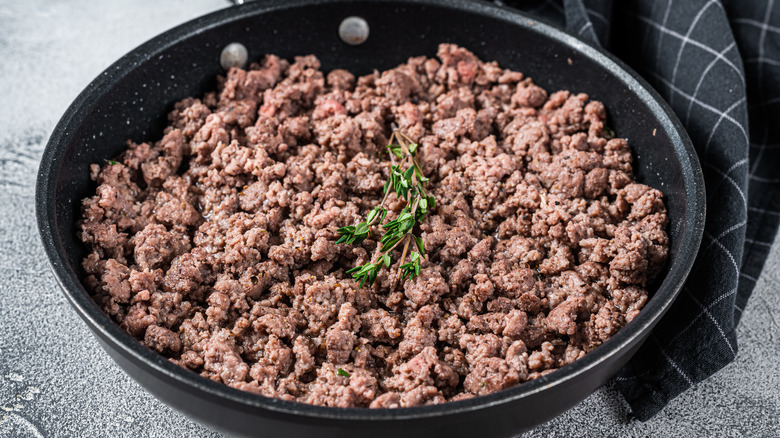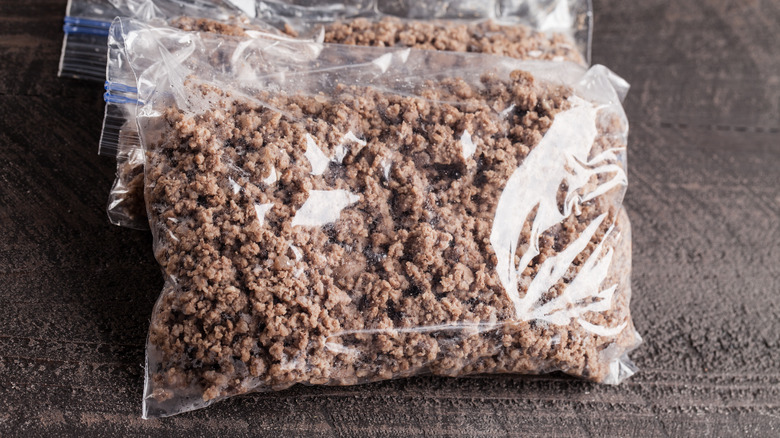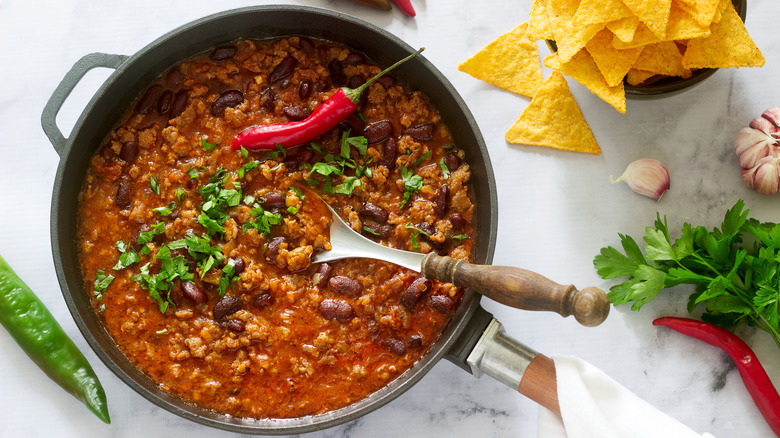Why You Should Boil Ground Beef Before Storing It In The Freezer
When you see ground beef on sale at the grocery store, visions of juicy burgers, hearty chili, and meaty lasagna might start dancing in your head. This butcher counter staple is so versatile that it's easy to buy extra. If you can't finish it all at once, the obvious solution is to freeze it; however, you might want to try boiling it first.
Raw ground beef has a surprisingly short shelf-life of just two days in the fridge, according to the USDA, and while freezing it raw helps the meat retain peak quality for up to four months, boiling it first offers extra perks. In the same way that bacon should be cooked before it's frozen to prevent sticking, pre-cooking ground beef saves you hassle down the line. While it takes a few extra minutes initially to boil the beef, you won't have to defrost it or even cook it for that long once you're ready to use it. Just toss the frozen crumbles into your taco filling or Sunday night ragu, heat it through, and enjoy.
Secondly, boiling is faster than browning the beef in batches. There's no need to worry about crowding a skillet when you can just dump all the beef into a big pot of water — and you can brown the beef from its frozen state when it's time to use it. Done the right way, pre-cooked, frozen ground beef stays at peak quality for just as long as its raw counterpart.
How to boil and freeze ground beef properly
To cook ground beef before freezing it, bring a large pot of water to boil. Pull the meat apart and crumble it with your hands first, to prevent it from clumping into a big glob in the water. Boil the beef just until no more pink parts are visible. (Remember that you're going to cook it again later, so overcooking it now will make it dry.) Remove the meat with a slotted spoon or spider strainer and let it drain on paper towels. Let it cool before storing it, or you could wind up with an uneven freezing job that presents a food safety risk.
You might be tempted to add seasonings to the beef after it's cooked, but consider leaving it plain for the time being. Flavoring the meat in advance makes it less versatile — what if you season it to make chili, but wind up needing it for pasta sauce? That said, if you intend to use ground beef for just one or two dishes, seasoning it in advance might be beneficial.
After boiling, transfer the beef to airtight, freezer-safe resealable plastic bags. Squeeze the air out so you can lay the bags flat before freezing, which saves space and decreases the chance of freezer burn. Also, make sure to store the meat in the back of your freezer, the coldest area where less temperature fluctuations occur. Changes in temperature over time can greatly degrade the quality of the beef.
More benefits of pre-cooked ground beef
There's another big benefit to boiling ground beef before freezing it: It's super easy to get rid of the leftover fat. If you brown the beef instead, you could dump the liquid fat from the pan into the trash, but this is messy and has a risk of leaks. When you boil the beef, though, the fat will rise to the top of the water. All you have to do is let the pot cool, scoop out the solidified fat, then pour the water through a mesh strainer into the sink, which will catch any lingering bits and save your pipes from clogs.
Also, as mentioned you don't have to defrost the meat once you're ready to use it (unless you're making a quick-cooking dish). In the latter case, let the beef thaw by moving it to your fridge — leaving it on the counter is a serious ground beef storage mistake, as it could grow dangerous bacteria. Thawed ground beef should be used up in one or two days, according to the USDA.
While you can refreeze ground beef, as long as it thawed in the fridge, do so within three days of defrosting. It will likely suffer a loss in quality, becoming more dry, so you might want to save it for simmering in rich sauces, or layer it into hearty casseroles.



